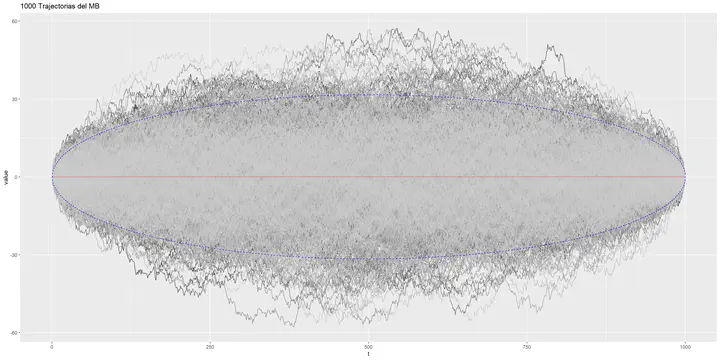Brownian Bridge
Brownian Bridge simulation in R.

Definición:
Un procesos estocástico \(\{X(t)= B(t) - \frac{t}{T} B(T) , 0 \leq t \leq T \}\), es un puente Browniano si satisface las siguientes propiedades:
1.- \(X(0)=X(T)=0\)
2.- \(X(t)\) se distribuye como una normal con media cero y varianza \(t(1-t/T)\)
$$E[X(t)] = 0$$, y $$Var(X(t)) = t(1-t/T)$$
3.- \(Cov(X(s), X(t)) = min(s, t) - \frac{st}{T}\)
Simulación
# Función para generar trajectorias del Puente Browniano (PB)
simPB <- function(t=1, nSteps, nReps){
dt <- t #/ nSteps
# Simulación de un Movimiento Browniano
BM <- matrix(nrow=nReps, ncol=(nSteps+1))
BM[ ,1] <- 0
for(i in 1:nReps){
for(j in 2:(nSteps + 1)){
BM[i,j] <- BM[i,j-1] + sqrt(dt)*rnorm(1,0,1)
}
}
# Simulación del puente Browniano
BB <- matrix(nrow=nReps, ncol=(nSteps+1))
BB[ ,1] <- 0
for(i in 1:nReps){
for(j in 2:(nSteps + 1)){
BB[i,j] <- BM[i,j]-(j/nSteps)*BM[i,nSteps+1]
}
}
# Data frame
names <- c('Rep', sapply(0:nSteps, function(i) paste('S',i,sep='')))
df <- data.frame('Rep'=1:nReps, BB)
colnames(df) <- names
return(df)
}
Ejemplo 1: Una trayectoria del Puente Browniano
# Ejemplo 1
t <- 1 # incrementos
nSteps <- 1000 # número de pasos
nReps <- 1 # número de trayectorias
pb1 <- simPB(t, nSteps, nReps)
# data
df <- pb1 %>%
pivot_longer(!Rep, names_to='Step', values_to='value') %>%
mutate(t = as.numeric(substring(Step,2,10))*t,
Rep = as.character(Rep))
head(df)
## # A tibble: 6 × 4
## Rep Step value t
## <chr> <chr> <dbl> <dbl>
## 1 1 S0 0 0
## 2 1 S1 0.411 1
## 3 1 S2 0.468 2
## 4 1 S3 0.878 3
## 5 1 S4 0.895 4
## 6 1 S5 2.04 5
# Valores teóricos
moments <- data.frame('t'=seq(from=0, to=nSteps, length=nSteps+1)*t) %>%
mutate('mean' = 0,
'sd_inf' = mean - 2*sqrt(t*(1-t/nSteps)),
'sd_sup' = mean + 2*sqrt(t*(1-t/nSteps)))
# Gráfico
options(repr.plot.width=16, repr.plot.height=8)
p1 <- ggplot(df, mapping=aes(x=t, y=value, color=Rep)) +
geom_line() +
geom_step(moments, mapping=aes(x=t,y=mean),col='red', linewidth=0.7, alpha=0.5) +
geom_step(moments, mapping=aes(x=t,y=sd_sup),col='blue', linewidth=0.7,linetype = "dashed") +
geom_step(moments, mapping=aes(x=t,y=sd_inf),col='blue', linewidth=0.7,linetype = "dashed") +
labs( title = paste(nReps, "Trajectorias del BB")) +
theme(legend.position = "none") +
scale_colour_grey(start = 0.2,end = 0.8)
#coord_cartesian(xlim = c(0, tmax))
p1

Ejemplo 2: Mil trayectorias del puente Browniano
# valores
t <- 1 # incremento
nSteps <- 1000 # número de pasos
nReps <- 1000 # número de trayectorias
pb1 <- simPB(t, nSteps, nReps)
# data
df <- pb1 %>%
pivot_longer(!Rep, names_to='Step', values_to='value') %>%
mutate(t = as.numeric(substring(Step,2,10))*t,
Rep = as.character(Rep))
head(df)
## # A tibble: 6 × 4
## Rep Step value t
## <chr> <chr> <dbl> <dbl>
## 1 1 S0 0 0
## 2 1 S1 0.139 1
## 3 1 S2 -0.224 2
## 4 1 S3 -0.579 3
## 5 1 S4 -0.114 4
## 6 1 S5 1.55 5
# Valores teóricas
moments <- data.frame('t'=seq(from=0, to=nSteps, length=nSteps+1)*t) %>%
mutate('mean' = 0,
'sd_inf' = mean - 2*sqrt(t*(1-t/nSteps)),
'sd_sup' = mean + 2*sqrt(t*(1-t/nSteps)))
# Gráfico del Puente Browniano
options(repr.plot.width=16, repr.plot.height=8)
p1 <- ggplot(df, mapping=aes(x=t, y=value, color=Rep)) +
geom_line() +
geom_step(moments, mapping=aes(x=t,y=mean),col='red', linewidth=0.7, alpha=0.5) +
geom_step(moments, mapping=aes(x=t,y=sd_sup),col='blue', linewidth=0.7,linetype = "dashed") +
geom_step(moments, mapping=aes(x=t,y=sd_inf),col='blue', linewidth=0.7,linetype = "dashed") +
labs( title = paste(nReps, "Trajectorias del MB")) +
theme(legend.position = "none") +
scale_colour_grey(start = 0.2,end = 0.8)
#coord_cartesian(xlim = c(0, tmax))
p1

Puente Browniano en dos dimensiones
# Puente Browniano en dos dimensiones
plot.PB2d <- function(base, n.steps){
df <- base
df_2d <- df %>%
gather(key='t',value='valor',-Rep) %>%
filter(Rep == 1 | Rep== 2) %>%
spread(Rep, valor) %>%
rename(Rep1 = '1', Rep2='2')%>%
mutate(t = as.numeric(substring(t,2,10))) %>%
arrange(t) %>%
filter(t <= n.steps)
b2 <- ggplot(df_2d,aes(x=Rep1,y=Rep2))+
geom_point(color="blue") +
geom_point(df_2d%>%filter(t == 0),mapping=aes(x=Rep1,y=Rep2), size=4, color="green") +
geom_point(df_2d%>%filter(t == max(t)),mapping=aes(x=Rep1,y=Rep2), size=3, color="red") +
geom_path() +
theme(axis.title.x = element_blank(),
axis.title.y = element_blank(),
axis.text.x=element_blank(),
axis.text.y=element_blank(),
axis.ticks.x=element_blank(),
axis.ticks.y=element_blank()
)
return(b2)
}
Ejemplo 1: Diez mil pasos
# Ejemplo 1:
t <- 1
nSteps <- 10000
nReps <- 1000
# Gráfico
options(repr.plot.width=14, repr.plot.height=10)
df <- simPB(t, nSteps, nReps)
p3 <- plot.PB2d(df, nSteps)
p3
